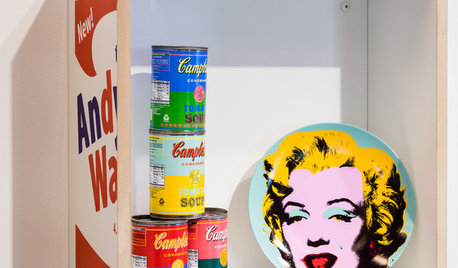Johnson v. Warhol
Herb
19 years ago
Related Stories

HEALTHY HOME6 Tips From a Nearly Zero-Waste Home
Lower your trash output and increase your quality of life with these ideas from a mom who did it to the max
Full Story
HOME TECHThe Inevitable Future of Drones Around Your Home
As Google joins the push for airborne deliveries, it seems only a matter of time before neighborhoods are buzzing with drones. Is that OK?
Full Story
EVENTSDesign Calendar: Where to Go and What to See in September
Works from a Pop Art icon, vibrant textiles, intricately crafted bamboo objects and designer dollhouses are on display this month
Full Story
DESIGN DETAILSThe Secret to Pocket Doors' Success
Pocket doors can be genius solutions for all kinds of rooms — but it’s the hardware that makes all the difference. See why
Full Story
ARTHere’s Looking at You: Supersize Portraiture at Home
Go big. Go bold. Hang huge portraits on blank walls for maximum impact
Full Story
KITCHEN DESIGN7 Strategies for a Well-Designed Kitchen
Get a kitchen that fits your lifestyle and your design tastes with these guidelines from an architect
Full Story
DECORATING GUIDESPop Culture Watch: 12 Home Trends from the '80s Are Back
Hold on to your hat (over your humongous hair); interior design elements of the 1980s have shot forward to today, in updated fashion
Full Story
GREAT HOME PROJECTSUpgrade Your Windows for Beauty, Comfort and Big Energy Savings
Bid drafts or stuffiness farewell and say hello to lower utility bills with new, energy-efficient windows
Full Story
GARDENING GUIDES6 Plants That Beat Butterfly Bush for the Wildlife Draw
It's invasive, a nonnative and a poor insect magnet. Check out these better alternatives to butterfly bush in the garden
Full Story
FUN HOUZZ31 True Tales of Remodeling Gone Wild
Drugs, sex, excess — the home design industry is rife with stories that will blow your mind, or at least leave you scratching your head
Full StorySponsored






edzard
HerbOriginal Author
Related Professionals
Middle River Landscape Architects & Landscape Designers · Brooklyn Center Landscape Architects & Landscape Designers · Bellefontaine Neighbors Landscape Contractors · Dallas Landscape Contractors · Lemay Landscape Contractors · Maywood Landscape Contractors · Oak Forest Landscape Contractors · Sugar Hill Landscape Contractors · Wailuku Landscape Contractors · Quartz Hill Landscape Contractors · Baker Decks, Patios & Outdoor Enclosures · Centennial Decks, Patios & Outdoor Enclosures · Crystal Lake Decks, Patios & Outdoor Enclosures · Fort Myers Decks, Patios & Outdoor Enclosures · Scotts Valley Decks, Patios & Outdoor Enclosuresinkognito
HerbOriginal Author
Gorfram
Gorfram
HerbOriginal Author
inkognito
jeepster
HerbOriginal Author
HerbOriginal Author
jeepster
edzard
HerbOriginal Author
Gorfram
edzard
HerbOriginal Author
nachodaddy
HerbOriginal Author
nachodaddy
Gorfram
HerbOriginal Author
gregoryjohn
jeepster
inkognito
edzard
HerbOriginal Author
Gorfram
ScottReil_GD
nachodaddy
HerbOriginal Author
ScottReil_GD
inkognito
ScottReil_GD
jeepster
Jando_1
ScottReil_GD
RckyM21
RckyM21